2.E: General Triangles (Exercises)

- Last updated
- May 26, 2022
- Save as PDF
- Page ID
- 3328
( \newcommand{\kernel}{\mathrm{null}\,}\)
These are homework exercises to accompany Corral's "Elementary Trigonometry" Textmap. This is a text on elementary trigonometry, designed for students who have completed courses in high-school algebra and geometry. Though designed for college students, it could also be used in high schools. The traditional topics are covered, but a more geometrical approach is taken than usual. Also, some numerical methods (e.g. the secant method for solving trigonometric equations) are discussed.
2.1 Exercises
For Exercises 1-9, solve the triangle
2.1.1
2.1.2
2.1.3
2.1.4
2.1.5
2.1.6
2.1.7
2.1.8
2.1.9
2.1.10 Draw a circle with a radius of 2 inches and inscribe a triangle inside the circle. Use a ruler and a protractor to measure the sides
2.1.11 An observer on the ground measures an angle of inclination of
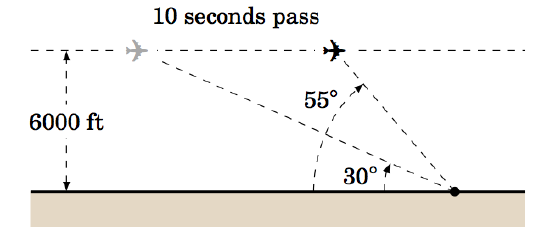
2.1.12 Prove the Law of Sines for right triangles. (Hint: One of the angles is known.)
2.1.13 For a triangle
2.1.14 For a triangle
2.1.15 One diagonal of a parallelogram is 17 cm long and makes angles of
2.1.16 Explain why in Case 1 (one side and two angles) there is always exactly one solution.
2.2 Exercises
For Exercises 1-6, solve the triangle
2.2.1
2.2.2
2.2.3
2.2.4
2.2.5
2.2.6
2.2.7 The diagonals of a parallelogram intersect at a
2.2.8 Two trains leave the same train station at the same time, moving along straight tracks that form a
2.2.9 Three circles with radii of
2.2.10 Find the length
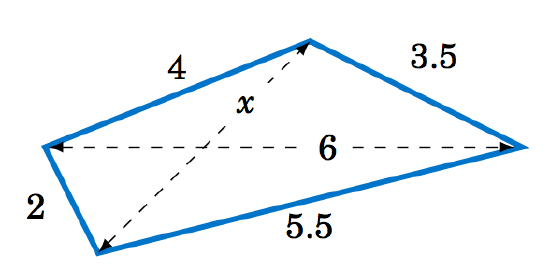
Figure 2.2.3 Exercise 10
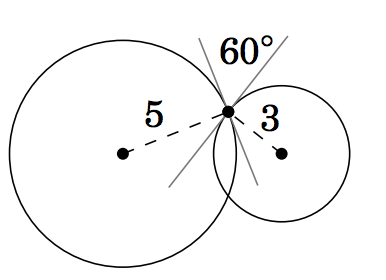
Figure 2.2.4 Exercise 11
2.2.11 Two circles of radii
2.2.12 Use the Law of Cosines to show that for any triangle
2.2.13 Show that for any triangle
2.2.14 Show that for any triangle
What do the terms in parentheses represent geometrically? Use your answer to explain why
2.2.15 Prove the Law of Cosines (i.e. Equations 2.9-2.11) for right triangles.
2.2.16 Recall from elementary geometry that a median of a triangle is a line segment from any vertex to the midpoint of the opposite side. Show that the sum of the squares of the three medians of a triangle is
2.2.17 The Dutch astronomer and mathematician Willebrord Snell (1580-1626) wrote the Law of Cosines as
in his trigonometry text Doctrina triangulorum (published a year after his death). Show that this formula is equivalent to Equation 2.11 in our statement of the Law of Cosines.
2.2.18 Suppose that a satellite in space, an earth station, and the center of the earth all lie in the same plane. Let
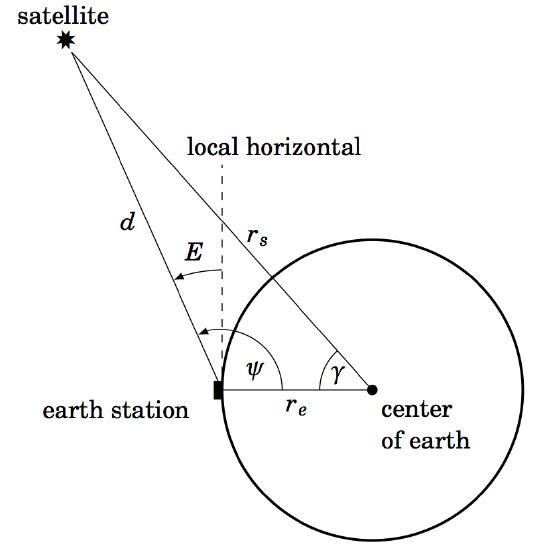
Figure 2.2.5
Use the Law of Cosines to show that
and then use
Note: This formula allows the angle of elevation
2.3 Exercises
For Exercises 1-3, use the Law of Tangents to solve the triangle
2.3.1
2.3.2
2.3.3
For Exercises 4-6, check if it is possible for a triangle to have the given parts.
2.3.4
2.3.5
2.3.6
2.3.7 Let
2.3.8 For any triangle
2.3.9 For any triangle
2.3.10 For any triangle
2.3.11 If
2.3.12 Let
2.4 Exercises
For Exercises 1-6, find the area of the triangle
2.4.1
2.4.2
2.4.3
2.4.4
2.4.5
2.4.6
2.4.7 Find the area of the quadrilateral in Figure 2.4.3 below.
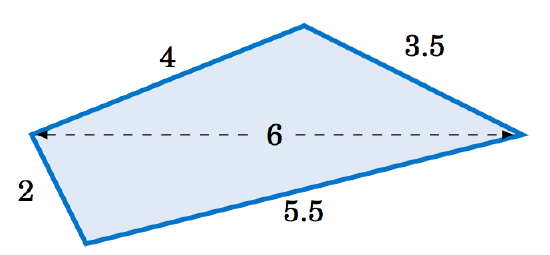
Figure 2.4.3 Exercise 7
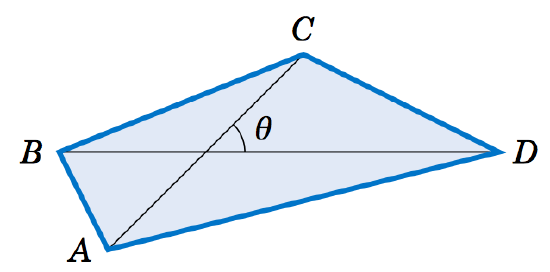
Figure 2.4.4 Exercise 8
2.4.8 Let
2.4.9 From Equation 2.26 derive the following formula for the area of a triangle
2.4.10 Show that the triangle area formula
is equivalent to Heron's formula. (Hint: In Heron's formula replace
2.4.11 Show that the triangle area Equation 2.34 is equivalent to Heron's formula. (Hint: Factor the expression inside the square root.)
2.4.12 Find the angle
2.5 Exercises
For Exercises 1-6, find the radii
2.5.1
2.5.2
2.5.3
2.5.4
2.5.5
2.5.6
For Exercises 7 and 8, draw the triangle
2.5.7
2.5.8
2.5.9 For any triangle
2.5.10 Show that for any triangle
2.5.11 Show that for any triangle
2.5.12 Let
(a) Find the exact value of the radius
(b) Find the exact value of the radius
(c) How much larger is
(d) Show that the circumscribed and inscribed circles of
2.5.13 Let


